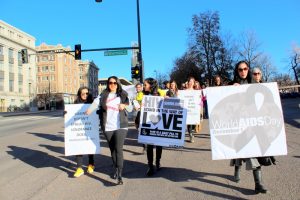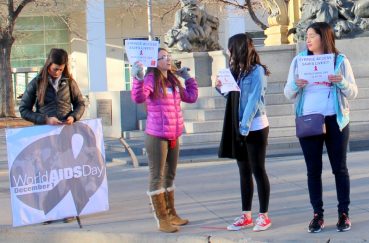Those driving and walking along Broadway and Colfax in downtown Denver were reminded that December 1 is World AIDS Day. Organized by the Harm Reduction Action Center, global recognition has existed since 1988 to show solidarity in the continued struggle to reduce HIV infections, to support people who are living with HIV and to honor those who have died of HIV/AIDS. In Denver Lisa Raville with the Harm Reduction Action Center said that the group has forged a presence sine 2009. Back then the Denver community didn’t have syringe access and she added, “When nobody would pay attention to us always out here on Colfax and Broadway.” Since then, legislation was passed in 2010 that provided for clean syringe access and other legislation that reduced the harms associated with overdose and the use of syringes. Raville said that her office is the largest syringe provider in the state and serve over 5,400 residents in the prevention of HIV transmission and Hepatitis C.
 About 37 million people worldwide are currently living with HIV/AIDS including 1.8 million children according to AIDS.gov. That includes 1.1 million who died in 2015 worldwide. The majority of those infections occur in poor and rural countries in Sub-Saharan Africa. Approximately 35 million people have died of HIV/AIDS or a related illness since 1984. Advocates working in the field caution against potential waning attention to the epidemic in some venues – such as in legislation and in the media – given the 2.1 million new infections reported worldwide in 2015. Local advocates encourage the conversation about HIV/AIDS beyond and outside of World AIDS Day. Currently only 60% of people with HIV know their status.
About 37 million people worldwide are currently living with HIV/AIDS including 1.8 million children according to AIDS.gov. That includes 1.1 million who died in 2015 worldwide. The majority of those infections occur in poor and rural countries in Sub-Saharan Africa. Approximately 35 million people have died of HIV/AIDS or a related illness since 1984. Advocates working in the field caution against potential waning attention to the epidemic in some venues – such as in legislation and in the media – given the 2.1 million new infections reported worldwide in 2015. Local advocates encourage the conversation about HIV/AIDS beyond and outside of World AIDS Day. Currently only 60% of people with HIV know their status.
 Advances in research and treatment though, have also brought people out into the streets in celebration. Robert Bellamy works with the Harm Reduction Action Center in Denver as an educator and does HIV testing. He said that HIV medication Truvada – also known as PrEP – is currently in use since the early part of this decade and studied with people who are both HIV-positive and negative. “They discovered that if you’re HIV negative and you take Truvada on a daily basis, it prevents HIV infection as well as condoms do. It’s analogous to birth control for HIV. You take the pill, and if you’re at very high risk it prevents HIV infection from occurring about 97% of the time depending on what study you’re looking at. It’s been a thing since about 2012, but only recently is it starting to become public knowledge. It’s obviously somewhat controversial. Some people believe it promotes unsafe sex and non-condom use and that other sexually transmitted infections may go up if people stop using condoms in lieu of PrEP.”
Advances in research and treatment though, have also brought people out into the streets in celebration. Robert Bellamy works with the Harm Reduction Action Center in Denver as an educator and does HIV testing. He said that HIV medication Truvada – also known as PrEP – is currently in use since the early part of this decade and studied with people who are both HIV-positive and negative. “They discovered that if you’re HIV negative and you take Truvada on a daily basis, it prevents HIV infection as well as condoms do. It’s analogous to birth control for HIV. You take the pill, and if you’re at very high risk it prevents HIV infection from occurring about 97% of the time depending on what study you’re looking at. It’s been a thing since about 2012, but only recently is it starting to become public knowledge. It’s obviously somewhat controversial. Some people believe it promotes unsafe sex and non-condom use and that other sexually transmitted infections may go up if people stop using condoms in lieu of PrEP.”
Other advancements include antiretroviral drugs that can control the virus so that people with HIV are able to live productive lives and reduce the risk of transmitting the virus to others however, there is still no cure for AIDS. As of June 2016, 18.2 million people living with HIV were accessing antiretroviral therapy (ART) worldwide, up from 15.8 million in June 2015, 7.5 million in 2010, and less than one million in 2000. Thirty million is the UNAIDS goal by 2020.
According to UNAIDS, the majority of those living with HIV live in sub-Saharan Africa where it is estimated to be 25.6 million in 2015. Most new infections (66%) originate from the same area as well and most people in need do not have access to testing or treatment.
A focus on prevention has led to the reduction of HIV rates as well as being acknowledged as the force behind a declining rate of infection. A greater number of highly affected yet economically poor countries have acquired the access to treatment in the recent past.
The world looks to Cuba for leadership in prevention and testing. It has been Cuba’s universal health care system that is credited for virtually eliminating HIV/AIDS in the tiny island nation that became the first in the world to virtually eliminate the spread of HIV and syphilis from mother to baby. Since a significant number of infections happen as a result of mother/child transmission, Cuba offers HIV-positive expectant mothers necessary medication, breastfeeding substitutes, and cesarean deliveries to avoid infection through contact with the birth canal. In addition to these figures, the World Health Organization (WHO) estimates that more than 95% of HIV-positive women who live in CUBA know their HIV status and have access to antiviral treatment.
Worldwide, the number of children born annually with HIV has been cut from 400,000 in 2009 to 240,000 in 2013. In 2015, 77% of pregnant women living with HIV globally had access to antiretroviral medicines.
But for now, without the access to universal health care and easy access to testing and drugs, the epidemic will continue yet at a slower pace. This in turn is said to impact a country’s reaching its potential in terms of social and economic impacts, leading to potential impacts of other diseases that impede a population from realizing its full potential.
According to organizers, World AIDS Day is a reminder to decision makers and the general public of the continued issues associated with the infection including the stigma. The Harm Reduction Center stood on street corners today hoping to raise awareness, confront prejudice and stigma and to increase public education.
Activists also handed out complimentary condoms in the effort to prevent infections locally.
Lisa Raville, Harm Reduction Action Center talks about the history of HIV and Hepatitis C prevention in Denver:
Robert Belamy, Harm Reduction Action Center talking about PrEP advances to prevent HIV infection:




